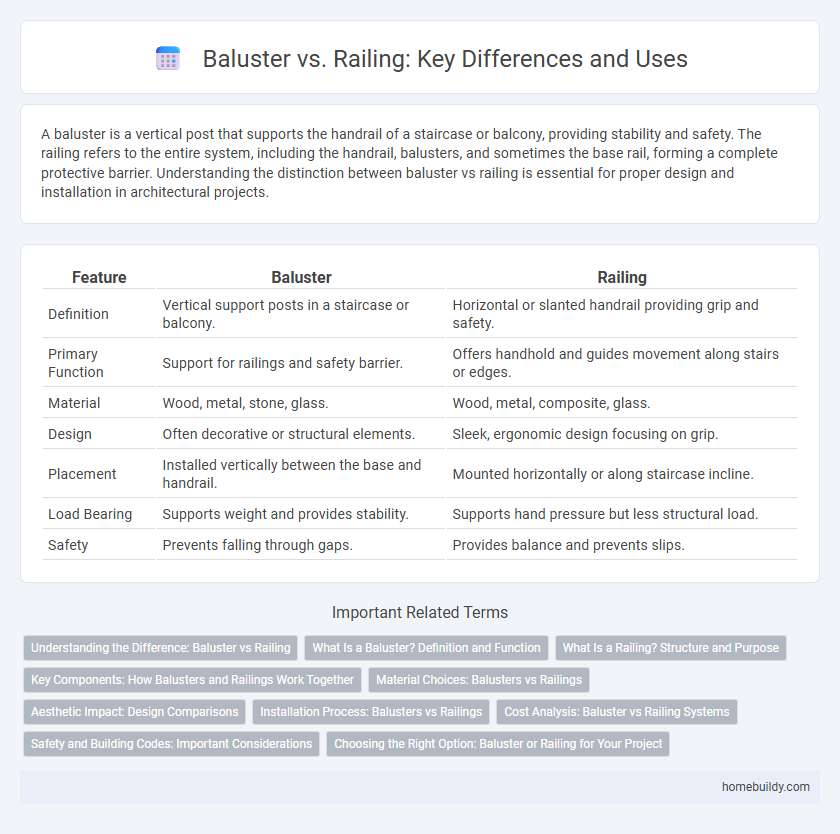A baluster is a vertical post that supports the handrail of a staircase or balcony, providing stability and safety. The railing refers to the entire system, including the handrail, balusters, and sometimes the base rail, forming a complete protective barrier. Understanding the distinction between baluster vs railing is essential for proper design and installation in architectural projects.
Table of Comparison
| Feature | Baluster | Railing |
|---|---|---|
| Definition | Vertical support posts in a staircase or balcony. | Horizontal or slanted handrail providing grip and safety. |
| Primary Function | Support for railings and safety barrier. | Offers handhold and guides movement along stairs or edges. |
| Material | Wood, metal, stone, glass. | Wood, metal, composite, glass. |
| Design | Often decorative or structural elements. | Sleek, ergonomic design focusing on grip. |
| Placement | Installed vertically between the base and handrail. | Mounted horizontally or along staircase incline. |
| Load Bearing | Supports weight and provides stability. | Supports hand pressure but less structural load. |
| Safety | Prevents falling through gaps. | Provides balance and prevents slips. |
Understanding the Difference: Baluster vs Railing
Balusters are the vertical posts that provide support and safety within a railing system, often designed with decorative elements to enhance architectural aesthetics. Railings refer to the entire horizontal structure, including handrails, balusters, and newel posts, serving as a protective barrier along staircases, balconies, or decks. Understanding this distinction clarifies that balusters are components of the railing system rather than standalone features.
What Is a Baluster? Definition and Function
A baluster is a vertical, spindle-shaped component that supports the handrail of a staircase or balcony, providing both structural stability and decorative appeal. Unlike a railing, which is the horizontal or angled bar designed for grasping, balusters serve as the intermediate supports that prevent falls and maintain the integrity of the railing system. Balusters can be made from various materials including wood, metal, or stone, and their design significantly influences the architectural style and safety of a staircase or balcony.
What Is a Railing? Structure and Purpose
A railing is a protective barrier typically composed of posts, balusters, and a handrail that defines the edge of staircases, balconies, or decks to prevent falls. Its structure consists of vertical supports, such as balusters, which provide stability and support the horizontal handrail for safety and balance. The primary purpose of a railing is to enhance safety, guide movement, and provide architectural design elements in residential and commercial buildings.
Key Components: How Balusters and Railings Work Together
Balusters serve as the vertical supports that connect the handrail to the base, providing structural stability and safety in staircases and balconies. Railings function as the horizontal or angled gripping surface designed for user support and guidance. Together, balusters and railings form an integrated framework that ensures both aesthetic appeal and functional security in architectural design.
Material Choices: Balusters vs Railings
Balusters are typically crafted from materials like wood, metal, stone, or glass, offering structural support and decorative detail, while railings are often made from metal, wood, or composite materials designed for hand grip and safety. Metal balusters, such as wrought iron or aluminum, provide durability and intricate designs, contrasting with wooden railings that emphasize warmth and traditional aesthetics. Selecting materials for both balusters and railings depends on factors like weather resistance, maintenance, and architectural style to ensure cohesive and long-lasting installations.
Aesthetic Impact: Design Comparisons
Balusters are vertical posts that provide decorative support within a railing system, significantly influencing the overall aesthetic of a staircase or balcony. Railing refers to the entire horizontal structure, including handrails, balusters, and sometimes newel posts, creating a cohesive visual flow. Comparing designs, intricately carved balusters offer detailed ornamentation that enhances elegance, while sleek modern railings emphasize minimalism and clean lines, shaping the style and visual impact of the architectural space.
Installation Process: Balusters vs Railings
Baluster installation involves securing individual vertical posts to the stair treads or floor, requiring precise measurements and anchoring for stability. Railing installation focuses on attaching horizontal or sloped rail components to supports such as balusters or wall brackets, often involving continuous runs for safety and aesthetics. While balusters provide structural support and decorative detail, railings serve as the main handhold, making their installation methods distinct yet complementary in staircase construction.
Cost Analysis: Baluster vs Railing Systems
Baluster systems typically involve individual vertical posts which can increase labor costs due to detailed installation compared to continuous railing systems that offer faster setup and potentially lower overall expenses. Material costs vary significantly with balusters requiring more components, while railing systems may use fewer materials but higher-grade metals or woods to ensure structural integrity. Homeowners should evaluate both upfront expenses and long-term maintenance costs when deciding between balusters and railing systems for budget efficiency.
Safety and Building Codes: Important Considerations
Balusters provide essential vertical support to railings, enhancing safety by preventing falls, especially in staircases and balconies. Building codes mandate specific baluster spacing, typically no more than 4 inches apart, to prevent small children from slipping through. Compliance with these regulations ensures both structural integrity and occupant protection in residential and commercial constructions.
Choosing the Right Option: Baluster or Railing for Your Project
Balusters are the vertical posts supporting a railing, providing both structural stability and aesthetic appeal, while railings serve as the horizontal or angled handrails for safety and guidance. Choosing between balusters and railings depends on the project's design requirements, safety standards, and material preferences, with balusters offering intricate design possibilities and railings emphasizing functional support. For outdoor applications, weather-resistant materials like stainless steel or treated wood enhance durability, making the right balance between baluster style and railing strength essential for a successful installation.
baluster vs railing Infographic

 homebuildy.com
homebuildy.com